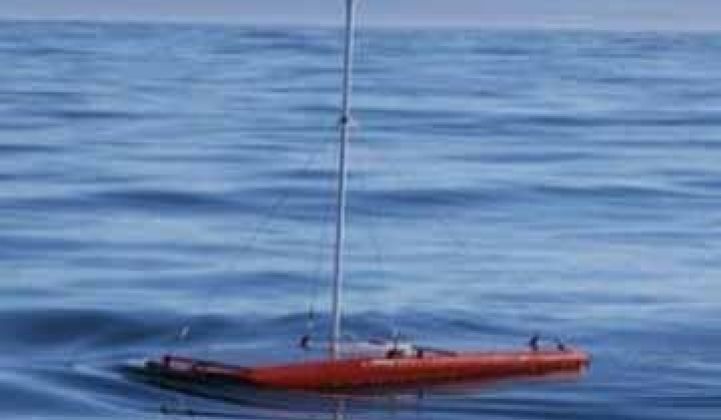The Wave Glider from Liquid Robotics was created as a way to conduct persistent, long-term research on marine life in the open water. But it could come in handy for the oil spill in the Gulf of Mexico, too.
Invented by company founders Joe Rizzi and Roger Hines, the device was originally invented as a vehicle that would let researchers eavesdrop on whales, but they soon turned to scientific, military and commercial applications.
The key innovation is the device's ability to harvest energy from ocean waves in order to provide essentially limitless propulsion. "It can stay a full year in the ocean, or longer, just floating here and there as directed, without maintenance," explained Dereck Hine, a mechanical engineer and advisor to Liquid Robotics.
"The Wave Glider carries sensors that can monitor almost anything in the ocean. The glider's fuel-less 'engine' is a stack of hydrofoil 'wings' about five feet long that sits 22 feet below the surface, tethered to the instrument platform floating on the surface that is equipped with sensors and the command center," said Hine.
The way the glider works is akin to an airplane's forward motion through the air, in which the wings create an upward lifting force. The submerged glider's vertical motion through the comparatively still waters at the glider's depth lets its wing array convert a portion of this upward motion into a forward propulsive force. As waves pass on the surface, the submerged glider acts as a tug, pulling the surface float along a predetermined course, controlled by a rudder on the surface float. Separating the glider from the float is a crucial aspect of the vehicle design.
Needing no fuel, the glider has trifling operating cost, said Hine. Two people, ashore or afloat in a ship, can control the device via satellite through an Internet interface. The Wave Glider's float carries photovoltaic solar panels, each rated to deliver up to 43 watts peak power. To backup and secure continual operation, for example at night, batteries are included.
In full production, a Wave Glider will cost hundreds of dollars. Custom one-offs, however, will cost $250,000, Hine said. The solar panels recharge its onboard batteries and provide up to 10 watts for communications, GPS and other sensors. The craft's course, independent of wave direction, is controlled by the radio-controlled rudder. "It's simple: log in from a laptop and tell it where to go. Since GPS works all the time, navigation can be very accurate," Hine explained.
Solutions in the middle of the ocean
The device can navigate at sea for months at a time; one device recently completed a 2,500-mile trip from Hawaii to San Diego, California. It also traveled to Alaska and back in severe weather.
Other potential uses for the Wave Glider include military applications, mapping the seafloor, patrolling marine reserves, monitoring coastal pollution and improving tsunami-warning systems. In these examples, the craft could replace monitoring buoys.
The U.S. National Oceanic and Atmospheric Administration (NOAA) has a global network of moored buoys that relay data from sensors measuring pressure on the ocean floor, looking for the tell-tale signs of a tsunami.
"Buoys change their position with wind and tide and often lose their moorings, and must be replaced by ship. This is costly and time-consuming. We can put a Wave Glider on an aircraft and deploy it, using a locally hired fishing boat, almost anywhere in the world, in under 48 hours," Hine said. Instead of moving in large circles -- as buoys do -- the Wave Glider can stay in one spot, emulating a buoy, but in a much more precise location.
The concept was developed several years ago when Rizzi attached a hydrophone to the original experimental device and secured it in a waterproof box during Hawaii's winter whale season. At that time he heard "the sound of frying bacon," not whales. But the basic concept -- wave propulsion in a system that needed no fuel -- had proved itself and has now been developed to the level of full operational practice. With half a dozen customers, Liquid Robotics is still cruising the seas of independence with no grants from the government, and is looking for more clients to become a free vessel in the entrepreneurial ocean.



